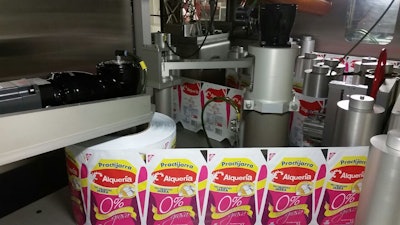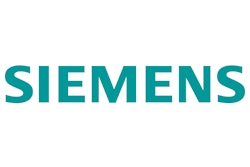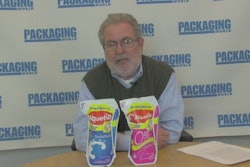Bogota-based Alqueria, a leading producer of dairy products in Colombia, recently launched 1-L stand-up pouches that are filled on an Air Aseptic packaging system from Ecolean.
The launch is significant not only because it marks Ecolean’s entry into the South American market but also because Alqueria is among the first to commercialize Ecolean’s innovative reclosing feature. Ecolean’s SnapQuick reclosing device was awarded a Scanstar 2014 packaging award in a competition that annually recognizes outstanding packaging innovations from all five Nordic countries. The Scanstar judges described the SnapQuick as a smart new closing feature for what already is an award-winning Air Aseptic concept. They also admired the fact that the solution is a successful combination of functionality and minimal material consumption. Alqueria calls its new package “practijarra,” which is Spanish for “practical jug.”
“Alquería Dairy is known for driving innovation, and the new Ecolean SnapQuick packaging format fits perfectly in our product portfolio,” says Carlos Cavelier, CEO of Alquería S.A. “We couldn’t be happier with the introduction; the package has been well received as it suits our consumers and makes it more practical and fun to consume milk.”
Cavelier acknowledges that the Ecolean stand-up pouch with its SnapQuick feature costs about twice as much as the aseptically filled pillow pouches that Alqueria has been filling for many years and still does. But he thinks Colombia is ready for a value-added, convenience-driven packaging concept like this. Some 95% of the Colombian market is pillow pouches. Whether it’s sold fresh and refrigerated or packaged aseptically for distribution at ambient temperatures, the consumer has to put these pouches into a rigid pitcher of some sort for day-to-day dispensing. Cavelier is betting that once consumers get used to a standup pouch that is its own reclosable dispensing container, they’ll gladly pay a premium to have it in their homes.
“We’ve been waiting for a standup pouch concept like this to come along,” says Cavelier. “With that convenient air-filled handle, it’s a beautiful solution. And now on top of the stand-up pouch convenience, they are introducing a reclosure feature. When we saw that, we knew it was time to jump on it.”
Innovative concept
Even without the SnapQuick feature, the Air Aseptic package is an unusual and innovative approach to putting liquids in a stand-up pouch. Its most distinctive feature is the air-filled handle to which Lozano refers, which gives the finished package a “spine” of sorts that makes the container very easy to grip. Also notable is that Ecolean minimizes the amount of petroleum-based material required by substituting a material it calls Calymer. A combination of PE, PP, and calcium carbonate, it’s mixed into the inner layers of the seven-layer coextrusion that is the base of the pouch substrate. This provides stiffness and whiteness while reducing the amount of plastic required.
Ecolean refers to the calcium carbonate as “one of nature’s own materials.” Its common name is “chalk.” The unique properties of Calymer result in a lightweight package that takes less energy to produce. Ecolean makes the following claims on comparative weights for 1-L packages:
• Ecolean Air 16 g
• Gabletop 31 g
• Gabletop with reclosure 37 g
• HDPE bottle 32 g
• PET bottle 36 g
Ecolean also claims that of the five 1-L packs listed above, the Ecolean Air is the “greenest” when it comes to energy consumption, production waste, water pollution, and greenhouse gas emissions.
These pouches are made by Ecolean in its Helsingborg, Sweden, headquarters facility. The first step is the seven-layer cast coextrusion. Various layers each contribute different properties. For example, the smooth surface is for high-quality printing, which Ecolean does on a flexo press in four colors plus lacquer coating. Also included is an EVOH layer for gas barrier purposes. Once coextrusion and printing are done, one converting step remains, as a PE layer is extrusion laminated to the food-contact side.
Specialized pouch-making equipment designed by Ecolean engineers is used to convert the finished substrate into a roll of pouches. These are shipped to Alqueria in 5,000-count rolls, four rolls to a pallet. The interior of each pouch has already been sterilized at Ecolean—during the folding processes that are part of pouch-forming—by means of Electron Beam technology from Crosslinking AB. When the rolls arrive at Alqueria, they’re hermetically sealed in clear film overwrap that gets removed just before that role is spliced into production. Also worth noting is the clever use of dancer bars to create a sizeable buffer so that the machine needn’t be stopped when it comes time to change to a new roll of pouches. A new roll can be put into place up to 15 minutes before a splice.
Filling three-up
In the case of Alqueria’s 1-L format, pouches are indexed into the Ecolean Model EL-3 three at a time. Before they enter the sterile zone where aseptic filling is done, they pass through a special module that attaches a SnapQuick reclosure feature to the corner of each pouch. Ecolean makes the SnapQuicks from a roll of PET that, through a die stamping process, is given two female cavities, two matching male counterparts, and a hinge down the middle. The SnapQuick parts arrive at Alqueria in a roll that’s fed into a mandrel module that picks one SnapQuick from its roll, heat-activates a pre-applied adhesive on the PET piece, and presses the piece against the pouch. Consumers open the pouch by tearing off a perforated corner marked “Abre Facil” (easy-opening). To reclose, simply fold along the hinge to get the SnapQuick’s male and female parts to snap together.
One more sequence is necessary before pouches enter the sterile filling zone. It’s a station where the exterior of the pouches is sprayed with a 1% solution of hydrogen peroxide and UV light. Once inside the aseptic zone, a high-speed rotary blade cuts off the top 1∕4 inch of each hermetically sealed pouch. Next, a scissor knife separates individual packs from the continuous roll and individual mechanical grippers hold each pack for transport to the next station.
In that next station, a new set of mechanical grippers grabs three pouches at a time and places them in a cradle that, combined with the grippers, will transport them through the remaining operations. The first of these is where vacuum suction cups pull open the top of the package just before transportation to the filling station. Once in the filling station, each pouch is lifted slightly so that it surrounds a filling valve. Rubber clamps fold the pouch material tightly around the filling valves so that the amount of oxygen that winds up in the finished container is minimized. In the next station, pouch tops are heat-sealed closed. In yet another station, the air handles are inflated with sterile air, and in a final station before pouches are discharged, the hole used to fill the air handle is heat-sealed closed.
In spite of the rather complex sequence of actions involved, the EL-3 at Alqueria operates at about 100 pouches/min. A Siemens PLC and Siemens servo drives and motors help make this possible.
The reclosable 1-L pouches, which have a 75-day shelf life at ambient temperatures, proceed to market in one of two formats. For the many small convenience stores (called “tiendas” in Colombia) that are so numerous in South America, a reusable red crate with a clear film liner is manually filled with 24 pouches. For supermarkets, however, operators put six pouches into a premade bag and heat-seal the bag by hand to make it convenient for consumers to buy the 1-L pouches six at a time.
Ecolean CEO Peter Nilsson sums up the Alqueria launch this way: “Alqueria is a company that drives innovation in the market, so working with such a company makes us proud. It is the perfect match for us. The cooperation has been nothing but extraordinary, and we are proud to now be present in the Colombian market. South America promises to offer many opportunities for Ecolean, and we already have new projects on the way.”
Watch an Off-the-Shelf video of this package at pwgo.to/1382
Watch additional video related to this article at pwgo.to/1340























